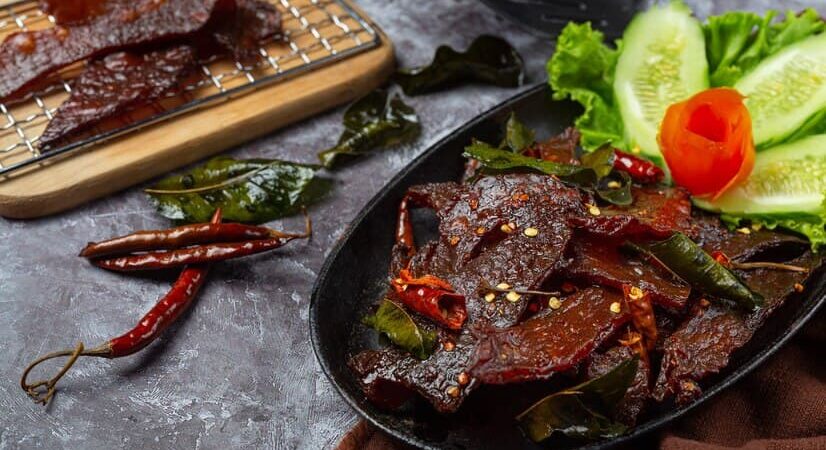Unlocking the secrets of Chinese meat tenderness involves mastering the art of marination. Chinese chefs employ meticulous techniques that not only infuse flavors but also tenderize meat to perfection. Let’s delve into the step-by-step process, ensuring you can replicate the magic in your own kitchen.
Marinating Methods
Chinese marination is a delicate dance of flavors and textures. Follow these steps to achieve the desired tenderness:
Step 1: Choose Quality Ingredients
Begin with fresh, high-quality meat. Opt for cuts like sirloin or tenderloin, known for their tenderness.
Step 2: Create the Base Marinade
Prepare a base marinade by combining soy sauce, rice wine, ginger, and sometimes garlic. Adjust quantities to your taste, keeping in mind that soy sauce adds saltiness, rice wine imparts sweetness, and ginger brings a subtle heat.
Step 3: Add Flavor Enhancers
Experiment with additional flavor enhancers such as honey, brown sugar, or a dash of sesame oil. These ingredients not only contribute to taste but also aid in the tenderizing process.
Step 4: Incorporate Natural Tenderizers
Introduce natural tenderizers like pineapple juice, papaya, or kiwi. These fruits contain enzymes that break down tough meat fibers. Be cautious with quantities, as excessive use can lead to overly tenderized meat.
Step 5: Marinate Strategically
Place the meat and marinade in a sealed container, ensuring every piece is evenly coated. Allow it to marinate in the refrigerator for at least 30 minutes to several hours, depending on the meat type. Longer marination times intensify the flavors and tenderize the meat further.
Velveting Technique
In addition to marination, Chinese cuisine embraces the velveting technique for an extra layer of tenderness:
Step 1: Slice and Coat
Thinly slice the marinated meat. In a separate bowl, create a coating mixture using egg whites and cornstarch. Coat each slice thoroughly.
Step 2: Blanch Quickly
Submerge the coated slices in hot water for a brief moment, creating a protective layer around the meat. This prevents moisture loss during cooking, resulting in exceptionally tender bites.
Secrets Behind Chinese Meat Tenderization
While marination and velveting lay the foundation for tenderizing meat in Chinese cuisine, there are additional secrets and modern techniques that elevate the art. Let’s uncover these hidden gems.
Natural Enzymes: A Culinary Alchemy
Chinese chefs often employ natural enzymes to tenderize meat. Ingredients like papaya, kiwi, or pineapple contain enzymes such as papain and bromelain. Incorporating small amounts of these fruits into your marinade imparts a subtle enzymatic action, breaking down tough fibers and enhancing tenderness. Exercise caution, as excessive use can lead to overly mushy results.
Proper Meat Cuts: The Backbone of Tenderness
The selection of meat cuts is pivotal. Chinese restaurants often opt for premium cuts like sirloin or tenderloin, which inherently boast tenderness. Choosing the right cut minimizes the effort required for tenderization and ensures a quality texture when cooked swiftly, preserving natural juices.
Flash Frying: The Quick and Crispy Touch
Chinese chefs embrace flash frying as a modern technique for tenderizing meat. This involves a rapid, high-heat cooking process that seals the outer layer of the meat, locking in moisture. The result is a delightful combination of tenderness on the inside and a crispy exterior, adding a textural dimension to the dish.
Stir-Frying with Cornstarch: A Protective Shield
Innovative stir-frying techniques often include the use of cornstarch. By coating the marinated meat with a thin layer of cornstarch before stir-frying, Chinese chefs create a protective shield. This shield prevents overcooking, maintaining the meat’s tenderness, and imparts a subtle crispiness to the surface.
Soy Sauce and Papaya Fusion
To further enhance tenderness, Chinese chefs often combine the richness of soy sauce with the enzymatic power of papaya. The soy sauce adds depth to the marinade, while papaya works its magic on the meat fibers. This dynamic duo not only tenderizes the meat but also imparts a unique flavor profile that is quintessentially Chinese.
Controlled Temperature Marination
Chinese culinary masters understand the impact of temperature on marination. For an extra layer of tenderness, consider marinating your meat at a controlled, slightly higher temperature. This allows the marinade to penetrate more effectively, ensuring every fiber is infused with flavor and tenderness.
Time-Honored Meat Hanging
In traditional Chinese kitchens, a fascinating technique involves hanging meat for a specific duration before cooking. This process allows natural enzymes within the meat to activate, breaking down tough fibers and enhancing tenderness. While not as commonly practiced today, it reflects the historical depth of Chinese culinary wisdom.
Modern Innovations in Meat Tenderization
In the realm of modern Chinese cuisine, vacuum tumbling technology has emerged as a game-changer. This technique involves placing meat in a vacuum-sealed container, allowing the marinade to penetrate deeply through the meat fibers.
The result is a remarkably tender texture achieved in a shorter time, catering to the demands of contemporary kitchens.
Sous Vide Precision
Chinese restaurants on the cutting edge of culinary innovation often turn to sous vide cooking. This method involves vacuum-sealing marinated meat and cooking it at a precisely controlled temperature for an extended period.
Uncover how to tenderize any meat in 30 minutes in this video
The slow, gentle cooking process guarantees optimal tenderness and amplifies the infusion of flavors, showcasing the continuous evolution of Chinese meat tenderization techniques.
Conclusion
The secrets behind Chinese meat tenderization weave a tapestry of tradition and innovation. By understanding the delicate balance of marination, velveting, and incorporating modern techniques like natural enzymes, flash frying, and vacuum tumbling, you can embark on a culinary journey that mirrors the mastery of Chinese restaurants.
Experiment with these techniques, infuse your dishes with flavor, and relish the tender results that define the essence of Chinese cuisine. Now, armed with these insights, you’re ready to bring the magic of Chinese meat tenderization into your own kitchen.
